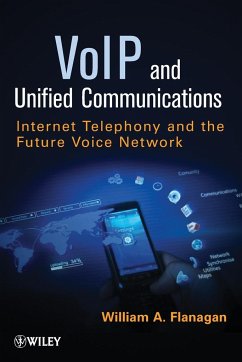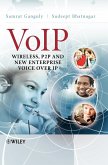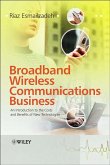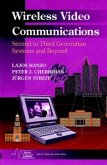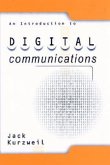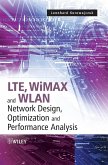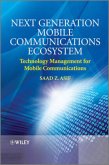- Broschiertes Buch
- Merkliste
- Auf die Merkliste
- Bewerten Bewerten
- Teilen
- Produkt teilen
- Produkterinnerung
- Produkterinnerung
Translates technical jargon into practical business communications solutions This book takes readers from traditional voice, fax, video, and data services delivered via separate platforms to a single, unified platform delivering all of these services seamlessly via the Internet. With its clear, jargon-free explanations, the author enables all readers to better understand and assess the growing number of voice over Internet protocol (VoIP) and unified communications (UC) products and services that are available for businesses. VoIP and Unified Communications is based on the author's careful…mehr
Andere Kunden interessierten sich auch für
![Voip Voip]() Samrat GangulyVoip127,99 €
Samrat GangulyVoip127,99 €![Broadband Wireless Communications Business Broadband Wireless Communications Business]() Riaz EsmailzadehBroadband Wireless Communications Business102,99 €
Riaz EsmailzadehBroadband Wireless Communications Business102,99 €![Wireless Video Communications Wireless Video Communications]() Lajos L. HanzoWireless Video Communications251,99 €
Lajos L. HanzoWireless Video Communications251,99 €![An Introduction to Digital Communications An Introduction to Digital Communications]() Jack KurzweilAn Introduction to Digital Communications315,99 €
Jack KurzweilAn Introduction to Digital Communications315,99 €![Lte, Wimax and Wlan Network Design, Optimization and Performance Analysis Lte, Wimax and Wlan Network Design, Optimization and Performance Analysis]() Leonhard Korowajczuk (Hrsg.)Lte, Wimax and Wlan Network Design, Optimization and Performance Analysis189,99 €
Leonhard Korowajczuk (Hrsg.)Lte, Wimax and Wlan Network Design, Optimization and Performance Analysis189,99 €![Next Generation Mobile Communications Ecosystem Next Generation Mobile Communications Ecosystem]() Saad Z. AsifNext Generation Mobile Communications Ecosystem122,99 €
Saad Z. AsifNext Generation Mobile Communications Ecosystem122,99 €![Communications Engineering Communications Engineering]() Richard Chia Tung LeeCommunications Engineering117,99 €
Richard Chia Tung LeeCommunications Engineering117,99 €-
-
-
Translates technical jargon into practical business communications solutions
This book takes readers from traditional voice, fax, video, and data services delivered via separate platforms to a single, unified platform delivering all of these services seamlessly via the Internet. With its clear, jargon-free explanations, the author enables all readers to better understand and assess the growing number of voice over Internet protocol (VoIP) and unified communications (UC) products and services that are available for businesses.
VoIP and Unified Communications is based on the author's careful review and synthesis of more than 7,000 pages of published standards as well as a broad range of datasheets, websites, white papers, and webinars. It begins with an introduction to IP technology and then covers such topics as:
Packet transmission and switching
VoIP signaling and call processing
How VoIP and UC are defining the future
Interconnections with global services
Network management for VoIP and UC
This book features a complete chapter dedicated to cost analyses and payback calculations, enabling readers to accurately determine the short- and long-term financial impact of migrating to various VoIP and UC products and services. There's also a chapter detailing major IP systems hardware and software. Throughout the book, diagrams illustrate how various VoIP and UC components and systems work. In addition, the author highlights potential problems and threats to UC services, steering readers away from common pitfalls.
Concise and to the point, this text enables readers--from novices to experienced engineers and technical managers--to understand how VoIP and UC really work so that everyone can confidently deal with network engineers, data center gurus, and top management.
Hinweis: Dieser Artikel kann nur an eine deutsche Lieferadresse ausgeliefert werden.
This book takes readers from traditional voice, fax, video, and data services delivered via separate platforms to a single, unified platform delivering all of these services seamlessly via the Internet. With its clear, jargon-free explanations, the author enables all readers to better understand and assess the growing number of voice over Internet protocol (VoIP) and unified communications (UC) products and services that are available for businesses.
VoIP and Unified Communications is based on the author's careful review and synthesis of more than 7,000 pages of published standards as well as a broad range of datasheets, websites, white papers, and webinars. It begins with an introduction to IP technology and then covers such topics as:
Packet transmission and switching
VoIP signaling and call processing
How VoIP and UC are defining the future
Interconnections with global services
Network management for VoIP and UC
This book features a complete chapter dedicated to cost analyses and payback calculations, enabling readers to accurately determine the short- and long-term financial impact of migrating to various VoIP and UC products and services. There's also a chapter detailing major IP systems hardware and software. Throughout the book, diagrams illustrate how various VoIP and UC components and systems work. In addition, the author highlights potential problems and threats to UC services, steering readers away from common pitfalls.
Concise and to the point, this text enables readers--from novices to experienced engineers and technical managers--to understand how VoIP and UC really work so that everyone can confidently deal with network engineers, data center gurus, and top management.
Hinweis: Dieser Artikel kann nur an eine deutsche Lieferadresse ausgeliefert werden.
Produktdetails
- Produktdetails
- Verlag: Wiley & Sons
- Artikelnr. des Verlages: 1W118019210
- 1. Auflage
- Seitenzahl: 320
- Erscheinungstermin: 20. März 2012
- Englisch
- Abmessung: 234mm x 156mm x 18mm
- Gewicht: 532g
- ISBN-13: 9781118019214
- ISBN-10: 1118019210
- Artikelnr.: 33275135
- Herstellerkennzeichnung
- Libri GmbH
- Europaallee 1
- 36244 Bad Hersfeld
- gpsr@libri.de
- Verlag: Wiley & Sons
- Artikelnr. des Verlages: 1W118019210
- 1. Auflage
- Seitenzahl: 320
- Erscheinungstermin: 20. März 2012
- Englisch
- Abmessung: 234mm x 156mm x 18mm
- Gewicht: 532g
- ISBN-13: 9781118019214
- ISBN-10: 1118019210
- Artikelnr.: 33275135
- Herstellerkennzeichnung
- Libri GmbH
- Europaallee 1
- 36244 Bad Hersfeld
- gpsr@libri.de
WILLIAM A. FLANAGAN is President and founder of Flanagan Consulting. With three decades of telecommunications experience, Mr. Flanagan is an expert in voice and data technologies, products, markets, and customers. His network designs have solved problems for enterprises, government agencies, and carriers.
Preface xiii
Acknowledgments xv
1 IP Technology Disrupts Voice Telephony 1
1.1 Introduction to the Public Switched Telephone Network 1
1.2 The Digital PSTN 2
1.3 The Packet Revolution in Telephony 8
1.3.1 Summary of Packet Switching 9
1.3.2 Link Capacity: TDM versus Packets 11
1.3.3 VoIP and "The Cloud" 13
IN SHORT: Reading Network Drawings 14
2 Traditional Telephones Still Set Expectations 17
2.1 Availability: How the Bell System Ensured Service 18
2.2 Call Completion 19
2.3 Sound Quality: Encoding for Recognizable Voices 20
2.4 Low Latency 23
2.5 Call Setup Delays 24
2.6 Impairments Controlled: Echo, Singing, Distortion, Noise 25
3 From Circuits to Packets 27
3.1 Data and Signaling Preceded Voice 27
3.1.1 X.25 Packet Data Service 27
3.1.2 SS7: PSTN Signaling on Packets 28
3.1.3 ISDN 29
3.2 Putting Voice into Packets 30
3.2.1 Voice Encoding 31
3.2.2 Dicing and Splicing Voice Streams 32
3.2.3 The Latency Budget 33
4 Packet Transmission and Switching 37
4.1 The Physical Layer: Transmission 39
IN SHORT: The Endian Wars 40
4.2 Data Link Protocols 41
4.3 IP, the Network Protocol 43
4.4 Layer 4 Transport Protocols 47
4.4.1 Transmission Control Protocol 47
4.4.2 User Datagram Protocol 50
4.4.3 Stream Control Transmission Protocol 51
4.5 Higher Layer Processes 54
4.5.1 RTP 54
4.5.2 RTCP 57
4.5.3 Multiplexing RTP and RTCP on One UDP Port 58
4.5.4 RTP Mixers and Translators 59
4.5.5 Layered Encoding 60
4.5.6 Profiles for Audio and Video Conferences 60
4.5.7 Security via Encryption 61
IN SHORT: Public Key Infrastructure (PKI) 62
4.6 Saving Bandwidth 64
4.6.1 Voice Compression 64
4.6.2 Header Compression 66
4.6.3 Silence Suppression, VAD 67
4.6.4 Sub-Packet Multiplexing 69
4.6.5 Protocol and Codec Selection 70
4.7 Differences: Circuit versus Packet Switched 71
4.7.1 Power to the Desktop Phone 71
4.7.2 Phone as Computer and Computer as Phone 72
4.7.3 Length of a Phone Line 72
4.7.4 Scaling to Large Size 75
4.7.5 Software Ownership and Licenses 75
5 VoIP Signaling and Call Processing 77
5.1 What Packet Voice and UC Systems Share 78
5.2 Session Initiation Protocol (SIP) 80
5.2.1 SIP Architecture 81
5.2.2 SIP Messages 88
5.2.3 SIP Header Fields and Behaviors 94
5.3 Session Description Protocol 101
IN SHORT: ABNF 104
5.4 Media Gateway Control Protocol 107
5.4.1 MGW Functions 107
5.4.2 MGW Connection Model 110
5.4.3 Megaco Procedures 112
5.4.4 Megaco Details 115
5.4.5 Signaling Conversion 119
5.4.6 Voice Transcoding 119
5.5 H.323 120
5.5.1 H.323 Architecture 121
5.5.2 Gatekeeper 123
5.5.3 Gateway 126
5.5.4 Terminal 126
5.5.5 Multipoint Control Unit 127
5.5.6 Call Procedures 128
5.6 Directory Services 134
5.6.1 Domain Name Service (DNS) 134
5.6.2 ENUM 135
6 VoIP and Unified Communications Define the Future 139
6.1 Voice as Before, with Additions 139
6.2 Legacy Services to Keep and Improve with VoIP 140
6.2.1 Flexible Call Routing and 800 Numbers 141
6.2.2 Call on Hold 141
6.2.3 Call Transfer 142
6.2.4 Call Forwarding 142
6.2.5 Audio Conferencing 142
6.2.6 Video Conferencing 143
6.2.7 Local Number Portability 144
6.2.8 Direct Inward Dialing, Dialed Number Indication 144
6.2.9 CallMessage Waiting 145
6.2.10 Call Recording 146
6.2.11 Emergency Calling (E911) 146
6.2.12 Tracking IP Phone Locations for E911 150
6.3 Facsimile Transmission 153
6.3.1 Facsimile on the PSTN 153
6.3.2 Real-Time Fax over IP: Fax Relay or T.38 155
6.3.3 Store-and-Forward Fax Handling 160
6.3.4 IP Faxing over the PSTN 161
6.4 Phone Features Added with VoIPUC 162
6.4.1 Presence 163
6.4.2 Forking 163
6.4.3 Voicemail¿eMail 163
6.4.4 SMS Integration 164
6.4.5 Instant Messaging 165
6.4.6 Webinar Broadcasts 168
6.4.7 Telepresence 168
6.4.8 More UC Features to Consider 168
7 How VoIP and UC Impact the Network 171
7.1 Space, Power, and Cooling 171
7.2 Priority for Voice, Video, Fax Packets 172
7.3 Packets per Second 174
7.4 Bandwidth 174
7.5 Security Issues 175
7.5.1 Eavesdropping and vLAN Hopping 176
7.5.2 Access Controls for Users and Connections 176
7.5.3 Modems 177
7.5.4 DNS Cache Poisoning 177
IN SHORT: Earliest Instance of DNS Cache Poisoning 179
7.5.5 Toll Fraud 179
7.5.6 Pay-per-Call Scams 179
7.5.7 Vishing 180
7.5.8 SIP ScanningSPIT 180
7.5.9 Opening the Firewall to Incoming Voice 181
7.6 First Migration Steps While Keeping Legacy Equipment 181
7.6.1 Circuit-Switched PBX 182
7.6.2 Digital Phones 182
7.6.3 Analog Phones and FX Service 183
7.6.4 Facsimile Machines 184
7.6.5 Modems 185
8 Interconnections to Global Services 187
8.1 Media Gateways 188
8.2 SIP Trunking 192
8.3 Operating VoIP Across Network Address Translation 196
8.3.1 Failures of SIP, SDP (Signaling) 199
8.3.2 Failures of RTP (Media) 199
8.3.3 Solutions 200
8.3.4 STUN: Session Traversal Utilities for NAT 201
8.3.5 TURN: Traversal Using Relays around NAT 204
8.3.6 ICE: Interactive Connectivity Establishment 206
8.4 Session Border Controller 207
8.4.1 Enterprise SBC 209
8.4.2 Carrier SBC 210
8.5 Supporting Multiple-Carrier Connections 212
8.6 Mobility and Wireless Access 213
8.6.1 VoIP on Wireless LANsWi-Fi 213
8.6.2 Integration of Wi-Fi and Cellular Services 214
8.6.3 Packet Voice on Mobile Broadband: WiMAX, LTE 214
8.6.4 Radio over VoIP 215
IN SHORT: E&M Voice Signaling 216
9 Network Management for VoIP and UC 217
9.1 Starting Right 218
9.1.1 Acceptance Testing 219
9.1.2 Configuration Management and Governance 220
9.1.3 Privilege Setting 220
9.2 Continuous Monitoring and Management 221
9.2.1 NMS Software 222
9.2.2 Simple Network Management Protocol 223
9.2.3 Web Interface 224
9.2.4 Server Logging 224
9.2.5 Software Maintenance 225
9.2.6 Quality of ServiceExperience Monitoring 225
9.2.7 Validate Adjustments and Optimization 226
9.3 Troubleshooting and Repair 226
9.3.1 Methods 226
9.3.2 Software Tools 228
9.3.3 Test Instruments 229
10 Cost Analysis and Payback Calculation 231
11 Examples of Hardware and Software 237
11.1 IP Phones 237
11.2 Gateways 240
11.3 Session Border Controllers 242
11.4 Call-Switching Servers 244
11.4.1 IP PBX 246
11.4.2 Conference BridgesControllers 248
11.4.3 Call Recorder 250
11.5 Hosted VoIPUC Service 251
11.6 Management SystemsWorkstations 252
12 Appendixes 253
12.1 Acronyms and Definitions 253
12.2 Reference Documents 268
12.2.1 RFCs 268
12.2.2 ITU Recommendations 272
12.2.3 Other Sources 272
12.3 Message and Error Codes 274
Index 277
Acknowledgments xv
1 IP Technology Disrupts Voice Telephony 1
1.1 Introduction to the Public Switched Telephone Network 1
1.2 The Digital PSTN 2
1.3 The Packet Revolution in Telephony 8
1.3.1 Summary of Packet Switching 9
1.3.2 Link Capacity: TDM versus Packets 11
1.3.3 VoIP and "The Cloud" 13
IN SHORT: Reading Network Drawings 14
2 Traditional Telephones Still Set Expectations 17
2.1 Availability: How the Bell System Ensured Service 18
2.2 Call Completion 19
2.3 Sound Quality: Encoding for Recognizable Voices 20
2.4 Low Latency 23
2.5 Call Setup Delays 24
2.6 Impairments Controlled: Echo, Singing, Distortion, Noise 25
3 From Circuits to Packets 27
3.1 Data and Signaling Preceded Voice 27
3.1.1 X.25 Packet Data Service 27
3.1.2 SS7: PSTN Signaling on Packets 28
3.1.3 ISDN 29
3.2 Putting Voice into Packets 30
3.2.1 Voice Encoding 31
3.2.2 Dicing and Splicing Voice Streams 32
3.2.3 The Latency Budget 33
4 Packet Transmission and Switching 37
4.1 The Physical Layer: Transmission 39
IN SHORT: The Endian Wars 40
4.2 Data Link Protocols 41
4.3 IP, the Network Protocol 43
4.4 Layer 4 Transport Protocols 47
4.4.1 Transmission Control Protocol 47
4.4.2 User Datagram Protocol 50
4.4.3 Stream Control Transmission Protocol 51
4.5 Higher Layer Processes 54
4.5.1 RTP 54
4.5.2 RTCP 57
4.5.3 Multiplexing RTP and RTCP on One UDP Port 58
4.5.4 RTP Mixers and Translators 59
4.5.5 Layered Encoding 60
4.5.6 Profiles for Audio and Video Conferences 60
4.5.7 Security via Encryption 61
IN SHORT: Public Key Infrastructure (PKI) 62
4.6 Saving Bandwidth 64
4.6.1 Voice Compression 64
4.6.2 Header Compression 66
4.6.3 Silence Suppression, VAD 67
4.6.4 Sub-Packet Multiplexing 69
4.6.5 Protocol and Codec Selection 70
4.7 Differences: Circuit versus Packet Switched 71
4.7.1 Power to the Desktop Phone 71
4.7.2 Phone as Computer and Computer as Phone 72
4.7.3 Length of a Phone Line 72
4.7.4 Scaling to Large Size 75
4.7.5 Software Ownership and Licenses 75
5 VoIP Signaling and Call Processing 77
5.1 What Packet Voice and UC Systems Share 78
5.2 Session Initiation Protocol (SIP) 80
5.2.1 SIP Architecture 81
5.2.2 SIP Messages 88
5.2.3 SIP Header Fields and Behaviors 94
5.3 Session Description Protocol 101
IN SHORT: ABNF 104
5.4 Media Gateway Control Protocol 107
5.4.1 MGW Functions 107
5.4.2 MGW Connection Model 110
5.4.3 Megaco Procedures 112
5.4.4 Megaco Details 115
5.4.5 Signaling Conversion 119
5.4.6 Voice Transcoding 119
5.5 H.323 120
5.5.1 H.323 Architecture 121
5.5.2 Gatekeeper 123
5.5.3 Gateway 126
5.5.4 Terminal 126
5.5.5 Multipoint Control Unit 127
5.5.6 Call Procedures 128
5.6 Directory Services 134
5.6.1 Domain Name Service (DNS) 134
5.6.2 ENUM 135
6 VoIP and Unified Communications Define the Future 139
6.1 Voice as Before, with Additions 139
6.2 Legacy Services to Keep and Improve with VoIP 140
6.2.1 Flexible Call Routing and 800 Numbers 141
6.2.2 Call on Hold 141
6.2.3 Call Transfer 142
6.2.4 Call Forwarding 142
6.2.5 Audio Conferencing 142
6.2.6 Video Conferencing 143
6.2.7 Local Number Portability 144
6.2.8 Direct Inward Dialing, Dialed Number Indication 144
6.2.9 CallMessage Waiting 145
6.2.10 Call Recording 146
6.2.11 Emergency Calling (E911) 146
6.2.12 Tracking IP Phone Locations for E911 150
6.3 Facsimile Transmission 153
6.3.1 Facsimile on the PSTN 153
6.3.2 Real-Time Fax over IP: Fax Relay or T.38 155
6.3.3 Store-and-Forward Fax Handling 160
6.3.4 IP Faxing over the PSTN 161
6.4 Phone Features Added with VoIPUC 162
6.4.1 Presence 163
6.4.2 Forking 163
6.4.3 Voicemail¿eMail 163
6.4.4 SMS Integration 164
6.4.5 Instant Messaging 165
6.4.6 Webinar Broadcasts 168
6.4.7 Telepresence 168
6.4.8 More UC Features to Consider 168
7 How VoIP and UC Impact the Network 171
7.1 Space, Power, and Cooling 171
7.2 Priority for Voice, Video, Fax Packets 172
7.3 Packets per Second 174
7.4 Bandwidth 174
7.5 Security Issues 175
7.5.1 Eavesdropping and vLAN Hopping 176
7.5.2 Access Controls for Users and Connections 176
7.5.3 Modems 177
7.5.4 DNS Cache Poisoning 177
IN SHORT: Earliest Instance of DNS Cache Poisoning 179
7.5.5 Toll Fraud 179
7.5.6 Pay-per-Call Scams 179
7.5.7 Vishing 180
7.5.8 SIP ScanningSPIT 180
7.5.9 Opening the Firewall to Incoming Voice 181
7.6 First Migration Steps While Keeping Legacy Equipment 181
7.6.1 Circuit-Switched PBX 182
7.6.2 Digital Phones 182
7.6.3 Analog Phones and FX Service 183
7.6.4 Facsimile Machines 184
7.6.5 Modems 185
8 Interconnections to Global Services 187
8.1 Media Gateways 188
8.2 SIP Trunking 192
8.3 Operating VoIP Across Network Address Translation 196
8.3.1 Failures of SIP, SDP (Signaling) 199
8.3.2 Failures of RTP (Media) 199
8.3.3 Solutions 200
8.3.4 STUN: Session Traversal Utilities for NAT 201
8.3.5 TURN: Traversal Using Relays around NAT 204
8.3.6 ICE: Interactive Connectivity Establishment 206
8.4 Session Border Controller 207
8.4.1 Enterprise SBC 209
8.4.2 Carrier SBC 210
8.5 Supporting Multiple-Carrier Connections 212
8.6 Mobility and Wireless Access 213
8.6.1 VoIP on Wireless LANsWi-Fi 213
8.6.2 Integration of Wi-Fi and Cellular Services 214
8.6.3 Packet Voice on Mobile Broadband: WiMAX, LTE 214
8.6.4 Radio over VoIP 215
IN SHORT: E&M Voice Signaling 216
9 Network Management for VoIP and UC 217
9.1 Starting Right 218
9.1.1 Acceptance Testing 219
9.1.2 Configuration Management and Governance 220
9.1.3 Privilege Setting 220
9.2 Continuous Monitoring and Management 221
9.2.1 NMS Software 222
9.2.2 Simple Network Management Protocol 223
9.2.3 Web Interface 224
9.2.4 Server Logging 224
9.2.5 Software Maintenance 225
9.2.6 Quality of ServiceExperience Monitoring 225
9.2.7 Validate Adjustments and Optimization 226
9.3 Troubleshooting and Repair 226
9.3.1 Methods 226
9.3.2 Software Tools 228
9.3.3 Test Instruments 229
10 Cost Analysis and Payback Calculation 231
11 Examples of Hardware and Software 237
11.1 IP Phones 237
11.2 Gateways 240
11.3 Session Border Controllers 242
11.4 Call-Switching Servers 244
11.4.1 IP PBX 246
11.4.2 Conference BridgesControllers 248
11.4.3 Call Recorder 250
11.5 Hosted VoIPUC Service 251
11.6 Management SystemsWorkstations 252
12 Appendixes 253
12.1 Acronyms and Definitions 253
12.2 Reference Documents 268
12.2.1 RFCs 268
12.2.2 ITU Recommendations 272
12.2.3 Other Sources 272
12.3 Message and Error Codes 274
Index 277
Preface xiii
Acknowledgments xv
1 IP Technology Disrupts Voice Telephony 1
1.1 Introduction to the Public Switched Telephone Network 1
1.2 The Digital PSTN 2
1.3 The Packet Revolution in Telephony 8
1.3.1 Summary of Packet Switching 9
1.3.2 Link Capacity: TDM versus Packets 11
1.3.3 VoIP and "The Cloud" 13
IN SHORT: Reading Network Drawings 14
2 Traditional Telephones Still Set Expectations 17
2.1 Availability: How the Bell System Ensured Service 18
2.2 Call Completion 19
2.3 Sound Quality: Encoding for Recognizable Voices 20
2.4 Low Latency 23
2.5 Call Setup Delays 24
2.6 Impairments Controlled: Echo, Singing, Distortion, Noise 25
3 From Circuits to Packets 27
3.1 Data and Signaling Preceded Voice 27
3.1.1 X.25 Packet Data Service 27
3.1.2 SS7: PSTN Signaling on Packets 28
3.1.3 ISDN 29
3.2 Putting Voice into Packets 30
3.2.1 Voice Encoding 31
3.2.2 Dicing and Splicing Voice Streams 32
3.2.3 The Latency Budget 33
4 Packet Transmission and Switching 37
4.1 The Physical Layer: Transmission 39
IN SHORT: The Endian Wars 40
4.2 Data Link Protocols 41
4.3 IP, the Network Protocol 43
4.4 Layer 4 Transport Protocols 47
4.4.1 Transmission Control Protocol 47
4.4.2 User Datagram Protocol 50
4.4.3 Stream Control Transmission Protocol 51
4.5 Higher Layer Processes 54
4.5.1 RTP 54
4.5.2 RTCP 57
4.5.3 Multiplexing RTP and RTCP on One UDP Port 58
4.5.4 RTP Mixers and Translators 59
4.5.5 Layered Encoding 60
4.5.6 Profiles for Audio and Video Conferences 60
4.5.7 Security via Encryption 61
IN SHORT: Public Key Infrastructure (PKI) 62
4.6 Saving Bandwidth 64
4.6.1 Voice Compression 64
4.6.2 Header Compression 66
4.6.3 Silence Suppression, VAD 67
4.6.4 Sub-Packet Multiplexing 69
4.6.5 Protocol and Codec Selection 70
4.7 Differences: Circuit versus Packet Switched 71
4.7.1 Power to the Desktop Phone 71
4.7.2 Phone as Computer and Computer as Phone 72
4.7.3 Length of a Phone Line 72
4.7.4 Scaling to Large Size 75
4.7.5 Software Ownership and Licenses 75
5 VoIP Signaling and Call Processing 77
5.1 What Packet Voice and UC Systems Share 78
5.2 Session Initiation Protocol (SIP) 80
5.2.1 SIP Architecture 81
5.2.2 SIP Messages 88
5.2.3 SIP Header Fields and Behaviors 94
5.3 Session Description Protocol 101
IN SHORT: ABNF 104
5.4 Media Gateway Control Protocol 107
5.4.1 MGW Functions 107
5.4.2 MGW Connection Model 110
5.4.3 Megaco Procedures 112
5.4.4 Megaco Details 115
5.4.5 Signaling Conversion 119
5.4.6 Voice Transcoding 119
5.5 H.323 120
5.5.1 H.323 Architecture 121
5.5.2 Gatekeeper 123
5.5.3 Gateway 126
5.5.4 Terminal 126
5.5.5 Multipoint Control Unit 127
5.5.6 Call Procedures 128
5.6 Directory Services 134
5.6.1 Domain Name Service (DNS) 134
5.6.2 ENUM 135
6 VoIP and Unified Communications Define the Future 139
6.1 Voice as Before, with Additions 139
6.2 Legacy Services to Keep and Improve with VoIP 140
6.2.1 Flexible Call Routing and 800 Numbers 141
6.2.2 Call on Hold 141
6.2.3 Call Transfer 142
6.2.4 Call Forwarding 142
6.2.5 Audio Conferencing 142
6.2.6 Video Conferencing 143
6.2.7 Local Number Portability 144
6.2.8 Direct Inward Dialing, Dialed Number Indication 144
6.2.9 CallMessage Waiting 145
6.2.10 Call Recording 146
6.2.11 Emergency Calling (E911) 146
6.2.12 Tracking IP Phone Locations for E911 150
6.3 Facsimile Transmission 153
6.3.1 Facsimile on the PSTN 153
6.3.2 Real-Time Fax over IP: Fax Relay or T.38 155
6.3.3 Store-and-Forward Fax Handling 160
6.3.4 IP Faxing over the PSTN 161
6.4 Phone Features Added with VoIPUC 162
6.4.1 Presence 163
6.4.2 Forking 163
6.4.3 Voicemail¿eMail 163
6.4.4 SMS Integration 164
6.4.5 Instant Messaging 165
6.4.6 Webinar Broadcasts 168
6.4.7 Telepresence 168
6.4.8 More UC Features to Consider 168
7 How VoIP and UC Impact the Network 171
7.1 Space, Power, and Cooling 171
7.2 Priority for Voice, Video, Fax Packets 172
7.3 Packets per Second 174
7.4 Bandwidth 174
7.5 Security Issues 175
7.5.1 Eavesdropping and vLAN Hopping 176
7.5.2 Access Controls for Users and Connections 176
7.5.3 Modems 177
7.5.4 DNS Cache Poisoning 177
IN SHORT: Earliest Instance of DNS Cache Poisoning 179
7.5.5 Toll Fraud 179
7.5.6 Pay-per-Call Scams 179
7.5.7 Vishing 180
7.5.8 SIP ScanningSPIT 180
7.5.9 Opening the Firewall to Incoming Voice 181
7.6 First Migration Steps While Keeping Legacy Equipment 181
7.6.1 Circuit-Switched PBX 182
7.6.2 Digital Phones 182
7.6.3 Analog Phones and FX Service 183
7.6.4 Facsimile Machines 184
7.6.5 Modems 185
8 Interconnections to Global Services 187
8.1 Media Gateways 188
8.2 SIP Trunking 192
8.3 Operating VoIP Across Network Address Translation 196
8.3.1 Failures of SIP, SDP (Signaling) 199
8.3.2 Failures of RTP (Media) 199
8.3.3 Solutions 200
8.3.4 STUN: Session Traversal Utilities for NAT 201
8.3.5 TURN: Traversal Using Relays around NAT 204
8.3.6 ICE: Interactive Connectivity Establishment 206
8.4 Session Border Controller 207
8.4.1 Enterprise SBC 209
8.4.2 Carrier SBC 210
8.5 Supporting Multiple-Carrier Connections 212
8.6 Mobility and Wireless Access 213
8.6.1 VoIP on Wireless LANsWi-Fi 213
8.6.2 Integration of Wi-Fi and Cellular Services 214
8.6.3 Packet Voice on Mobile Broadband: WiMAX, LTE 214
8.6.4 Radio over VoIP 215
IN SHORT: E&M Voice Signaling 216
9 Network Management for VoIP and UC 217
9.1 Starting Right 218
9.1.1 Acceptance Testing 219
9.1.2 Configuration Management and Governance 220
9.1.3 Privilege Setting 220
9.2 Continuous Monitoring and Management 221
9.2.1 NMS Software 222
9.2.2 Simple Network Management Protocol 223
9.2.3 Web Interface 224
9.2.4 Server Logging 224
9.2.5 Software Maintenance 225
9.2.6 Quality of ServiceExperience Monitoring 225
9.2.7 Validate Adjustments and Optimization 226
9.3 Troubleshooting and Repair 226
9.3.1 Methods 226
9.3.2 Software Tools 228
9.3.3 Test Instruments 229
10 Cost Analysis and Payback Calculation 231
11 Examples of Hardware and Software 237
11.1 IP Phones 237
11.2 Gateways 240
11.3 Session Border Controllers 242
11.4 Call-Switching Servers 244
11.4.1 IP PBX 246
11.4.2 Conference BridgesControllers 248
11.4.3 Call Recorder 250
11.5 Hosted VoIPUC Service 251
11.6 Management SystemsWorkstations 252
12 Appendixes 253
12.1 Acronyms and Definitions 253
12.2 Reference Documents 268
12.2.1 RFCs 268
12.2.2 ITU Recommendations 272
12.2.3 Other Sources 272
12.3 Message and Error Codes 274
Index 277
Acknowledgments xv
1 IP Technology Disrupts Voice Telephony 1
1.1 Introduction to the Public Switched Telephone Network 1
1.2 The Digital PSTN 2
1.3 The Packet Revolution in Telephony 8
1.3.1 Summary of Packet Switching 9
1.3.2 Link Capacity: TDM versus Packets 11
1.3.3 VoIP and "The Cloud" 13
IN SHORT: Reading Network Drawings 14
2 Traditional Telephones Still Set Expectations 17
2.1 Availability: How the Bell System Ensured Service 18
2.2 Call Completion 19
2.3 Sound Quality: Encoding for Recognizable Voices 20
2.4 Low Latency 23
2.5 Call Setup Delays 24
2.6 Impairments Controlled: Echo, Singing, Distortion, Noise 25
3 From Circuits to Packets 27
3.1 Data and Signaling Preceded Voice 27
3.1.1 X.25 Packet Data Service 27
3.1.2 SS7: PSTN Signaling on Packets 28
3.1.3 ISDN 29
3.2 Putting Voice into Packets 30
3.2.1 Voice Encoding 31
3.2.2 Dicing and Splicing Voice Streams 32
3.2.3 The Latency Budget 33
4 Packet Transmission and Switching 37
4.1 The Physical Layer: Transmission 39
IN SHORT: The Endian Wars 40
4.2 Data Link Protocols 41
4.3 IP, the Network Protocol 43
4.4 Layer 4 Transport Protocols 47
4.4.1 Transmission Control Protocol 47
4.4.2 User Datagram Protocol 50
4.4.3 Stream Control Transmission Protocol 51
4.5 Higher Layer Processes 54
4.5.1 RTP 54
4.5.2 RTCP 57
4.5.3 Multiplexing RTP and RTCP on One UDP Port 58
4.5.4 RTP Mixers and Translators 59
4.5.5 Layered Encoding 60
4.5.6 Profiles for Audio and Video Conferences 60
4.5.7 Security via Encryption 61
IN SHORT: Public Key Infrastructure (PKI) 62
4.6 Saving Bandwidth 64
4.6.1 Voice Compression 64
4.6.2 Header Compression 66
4.6.3 Silence Suppression, VAD 67
4.6.4 Sub-Packet Multiplexing 69
4.6.5 Protocol and Codec Selection 70
4.7 Differences: Circuit versus Packet Switched 71
4.7.1 Power to the Desktop Phone 71
4.7.2 Phone as Computer and Computer as Phone 72
4.7.3 Length of a Phone Line 72
4.7.4 Scaling to Large Size 75
4.7.5 Software Ownership and Licenses 75
5 VoIP Signaling and Call Processing 77
5.1 What Packet Voice and UC Systems Share 78
5.2 Session Initiation Protocol (SIP) 80
5.2.1 SIP Architecture 81
5.2.2 SIP Messages 88
5.2.3 SIP Header Fields and Behaviors 94
5.3 Session Description Protocol 101
IN SHORT: ABNF 104
5.4 Media Gateway Control Protocol 107
5.4.1 MGW Functions 107
5.4.2 MGW Connection Model 110
5.4.3 Megaco Procedures 112
5.4.4 Megaco Details 115
5.4.5 Signaling Conversion 119
5.4.6 Voice Transcoding 119
5.5 H.323 120
5.5.1 H.323 Architecture 121
5.5.2 Gatekeeper 123
5.5.3 Gateway 126
5.5.4 Terminal 126
5.5.5 Multipoint Control Unit 127
5.5.6 Call Procedures 128
5.6 Directory Services 134
5.6.1 Domain Name Service (DNS) 134
5.6.2 ENUM 135
6 VoIP and Unified Communications Define the Future 139
6.1 Voice as Before, with Additions 139
6.2 Legacy Services to Keep and Improve with VoIP 140
6.2.1 Flexible Call Routing and 800 Numbers 141
6.2.2 Call on Hold 141
6.2.3 Call Transfer 142
6.2.4 Call Forwarding 142
6.2.5 Audio Conferencing 142
6.2.6 Video Conferencing 143
6.2.7 Local Number Portability 144
6.2.8 Direct Inward Dialing, Dialed Number Indication 144
6.2.9 CallMessage Waiting 145
6.2.10 Call Recording 146
6.2.11 Emergency Calling (E911) 146
6.2.12 Tracking IP Phone Locations for E911 150
6.3 Facsimile Transmission 153
6.3.1 Facsimile on the PSTN 153
6.3.2 Real-Time Fax over IP: Fax Relay or T.38 155
6.3.3 Store-and-Forward Fax Handling 160
6.3.4 IP Faxing over the PSTN 161
6.4 Phone Features Added with VoIPUC 162
6.4.1 Presence 163
6.4.2 Forking 163
6.4.3 Voicemail¿eMail 163
6.4.4 SMS Integration 164
6.4.5 Instant Messaging 165
6.4.6 Webinar Broadcasts 168
6.4.7 Telepresence 168
6.4.8 More UC Features to Consider 168
7 How VoIP and UC Impact the Network 171
7.1 Space, Power, and Cooling 171
7.2 Priority for Voice, Video, Fax Packets 172
7.3 Packets per Second 174
7.4 Bandwidth 174
7.5 Security Issues 175
7.5.1 Eavesdropping and vLAN Hopping 176
7.5.2 Access Controls for Users and Connections 176
7.5.3 Modems 177
7.5.4 DNS Cache Poisoning 177
IN SHORT: Earliest Instance of DNS Cache Poisoning 179
7.5.5 Toll Fraud 179
7.5.6 Pay-per-Call Scams 179
7.5.7 Vishing 180
7.5.8 SIP ScanningSPIT 180
7.5.9 Opening the Firewall to Incoming Voice 181
7.6 First Migration Steps While Keeping Legacy Equipment 181
7.6.1 Circuit-Switched PBX 182
7.6.2 Digital Phones 182
7.6.3 Analog Phones and FX Service 183
7.6.4 Facsimile Machines 184
7.6.5 Modems 185
8 Interconnections to Global Services 187
8.1 Media Gateways 188
8.2 SIP Trunking 192
8.3 Operating VoIP Across Network Address Translation 196
8.3.1 Failures of SIP, SDP (Signaling) 199
8.3.2 Failures of RTP (Media) 199
8.3.3 Solutions 200
8.3.4 STUN: Session Traversal Utilities for NAT 201
8.3.5 TURN: Traversal Using Relays around NAT 204
8.3.6 ICE: Interactive Connectivity Establishment 206
8.4 Session Border Controller 207
8.4.1 Enterprise SBC 209
8.4.2 Carrier SBC 210
8.5 Supporting Multiple-Carrier Connections 212
8.6 Mobility and Wireless Access 213
8.6.1 VoIP on Wireless LANsWi-Fi 213
8.6.2 Integration of Wi-Fi and Cellular Services 214
8.6.3 Packet Voice on Mobile Broadband: WiMAX, LTE 214
8.6.4 Radio over VoIP 215
IN SHORT: E&M Voice Signaling 216
9 Network Management for VoIP and UC 217
9.1 Starting Right 218
9.1.1 Acceptance Testing 219
9.1.2 Configuration Management and Governance 220
9.1.3 Privilege Setting 220
9.2 Continuous Monitoring and Management 221
9.2.1 NMS Software 222
9.2.2 Simple Network Management Protocol 223
9.2.3 Web Interface 224
9.2.4 Server Logging 224
9.2.5 Software Maintenance 225
9.2.6 Quality of ServiceExperience Monitoring 225
9.2.7 Validate Adjustments and Optimization 226
9.3 Troubleshooting and Repair 226
9.3.1 Methods 226
9.3.2 Software Tools 228
9.3.3 Test Instruments 229
10 Cost Analysis and Payback Calculation 231
11 Examples of Hardware and Software 237
11.1 IP Phones 237
11.2 Gateways 240
11.3 Session Border Controllers 242
11.4 Call-Switching Servers 244
11.4.1 IP PBX 246
11.4.2 Conference BridgesControllers 248
11.4.3 Call Recorder 250
11.5 Hosted VoIPUC Service 251
11.6 Management SystemsWorkstations 252
12 Appendixes 253
12.1 Acronyms and Definitions 253
12.2 Reference Documents 268
12.2.1 RFCs 268
12.2.2 ITU Recommendations 272
12.2.3 Other Sources 272
12.3 Message and Error Codes 274
Index 277

